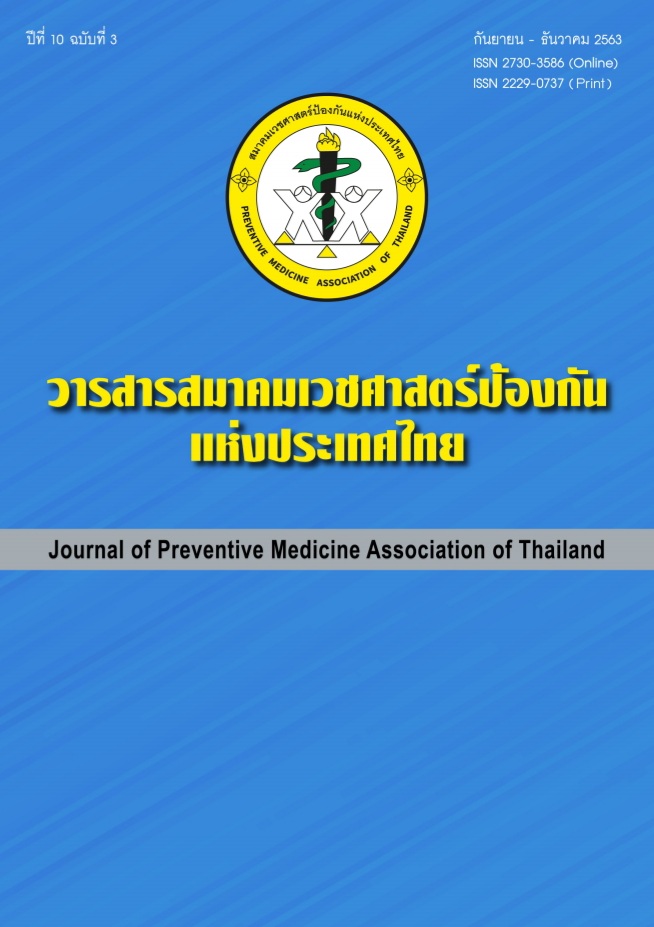A Model of Intermediate Care in Stroke Patients, Uthai Thani Province
Keywords:
model, intermediate care, stroke patientsAbstract
The objectives of this research and development were to 1) study situation of intermediate care in stroke patients, Uthai Thani Province 2) develop the pattern of intermediate care in stroke patients, Uthai Thani Province, and 3) study the effectiveness of intermediate care model in stroke patients, Uthai Thani Province . The research was divided into 3 steps including: 1) study situation of intermediate care in stroke patients, Uthai Thani Province. Focus group discussion was conducted among 9 informants. Data were analyzed using content analysis; 2) developing the intermediate care model in stroke patients. The researcher used the findings from the first step to develop the intermediate care model in stroke patients namely UTHAI model; 3) study the effectiveness of the UTHAI model. Sample was 27 stroke patients. The research instruments were the UTHAI model, and the questionnaire. Data were analyzed using repeated measure ANOVA and Paired t-test. The results revealed as follows;
- Situations of intermediate care in stroke patients, Uthai Thani Province included
1) Referrals for continuing care are not covered yet, 2) The patient received intermittent rehabilitation, 3) Some of the rehabilitation models and visitation guidelines were inconsistent with the problem and context of the patient, and 4) The frequency of visitation did not meet the intermediate care visit criteria.
- The UTHAI model included 1) U: Unit 2) T: Team 3) H: Home health care 4) A: Assistance from community and 5) I: Implementation
- After using the UTHAI model 1 month and 3 months , the sample group had barthel index of activities of daily living and quality of life higher than before using the model with statistical significance (p<.01)
References
2. โรงพยาบาลอุทัยธานี. สถิติผู้ป่วยโรคหลอดเลือดสมอง. อุทัยธานี: โรงพยาบาลอุทัยธานี; 2562.
3. จิตติมา แสงสุวรรณ. เวชศาสตร์ฟื้นฟูในผู้ป่วยโรคหลอดเลือดสมอง.ขอนแก่น: ภาควิชาเวชศาสตร์ฟื้นฟู คณะแพทยศาสตร์ มหาวิทยาลัยขอนแก่น; 2560.
4. รัชวรรณ สุขเสถียร. การเข้าถึงบริการเวชกรรมฟื้นฟูโรคหลอดเลือดสมองระยะ เฉียบพลันแบบผู้ป่วยใน ณ โรงพยาบาลมหาราช นครราชสีมา:ปัจจัยที่เกี่ยวข้องและผลลัพธ์. เวชศาสตร์ฟื้นฟูสาร 2557; 24:37-43.
5. สำนักงานวิจัยและพัฒนากำลังคนด้านสุขภาพ. การประเมินผลระบบการให้บริการการดูแลระยะกลาง. นนทบุรี: สำนักงานพัฒนานโยบายสุขภาพระหว่างประเทศ กระทรวงสาธารณสุข; 2562.
6. โรงพยาบาลอุทัยธานี. รายงานผลการดำเนินงานการดูแลผู้ป่วยระยะกลาง จังหวัดอุทัยธานี. อุทัยธานี: โรงพยาบาลอุทัยธานี; 2562.
7. Crabtree BF, Miller WL. Doing Qualitative Research. London: SAGE Publications; 1992.
8. Cohen J. Statistical power analysis for the behavioral science. 2nd ed. Hillsdale (NY): Lawrence Erlbaum Associates; 1988.
9. ปราโมทย์ ถ่างกระโทก, วชิรา โพธิ์ใส, เพลินตา พิพัฒน์สมบัติ, วินัย ไตรนาทถวัลย์, วานิช สุขสถาน. ความตรงและความเที่ยงของแบบวัดคุณภาพชีวิตเฉพาะผู้ป่วยโรคหลอดเลือดสมอง ฉบับภาษาไทย. วารสารการแพทย์และวิทยาศาสตร์สุขภาพ 2562;26:33-43.
10. กรมการแพทย์ กระทรวงสาธารณสุข. รูปแบบการดูแลสุขภาพระยะกลางของผู้สูงอายุในประเทศไทย. กรุงเทพฯ: บียอนด์ พับลิสชิ่ง จำกัด; 2562.
11. เครือวัลย์ เปี่ยมบริบูรณ์, จรูญลักษณ์ ป้องเจริญ. การพัฒนารูปแบบการดูแลผู้ป่วยโรคหลอดเลือดสมอง โรงพยาบาลเจ้าพระยายมราช สุพรรณบุรี. วารสารพยาบาลกระทรวงสาธารณสุข 2557;21:4-21.
12. อมรรัตน์ กุลทิพรรธ์, วัราภรณ์ โต๊ะทอง, จีระกานต์ สุขเมือง. การพัฒนารูปแบบการดูแลผู้ป่วยโรคหลอดเลือดสมองแบบครบวงจร เครือข่ายโรงพยาบาลเพชรบูรณ์. วารสารการแพทย์เขต11 2560;31: 619-30.
Downloads
Published
How to Cite
Issue
Section
License
บทความที่ลงพิมพ์ในวารสารเวชศาสตร์ป้องกันแห่งประเทศไทย ถือเป็นผลงานวิชาการ งานวิจัย วิเคราะห์ วิจารณ์ เป็นความเห็นส่วนตัวของผู้นิพนธ์ กองบรรณาธิการไม่จำเป็นต้องเห็นด้วยเสมอไปและผู้นิพนธ์จะต้องรับผิดชอบต่อบทความของตนเอง






